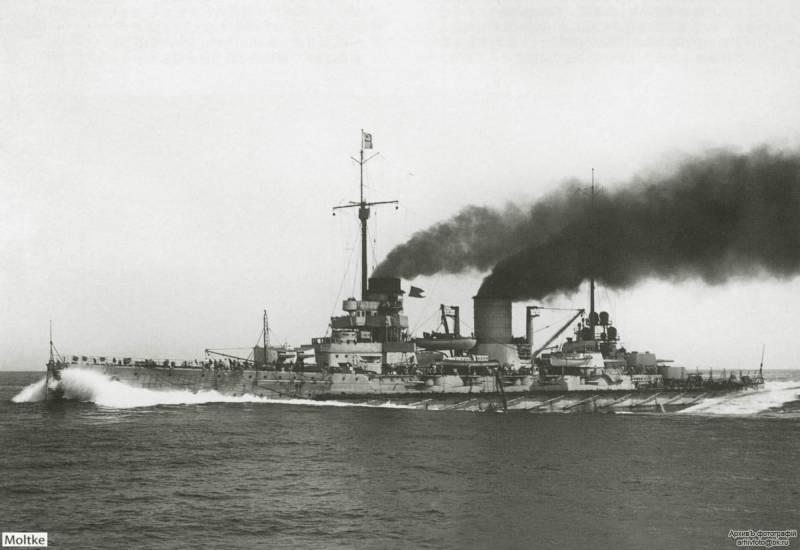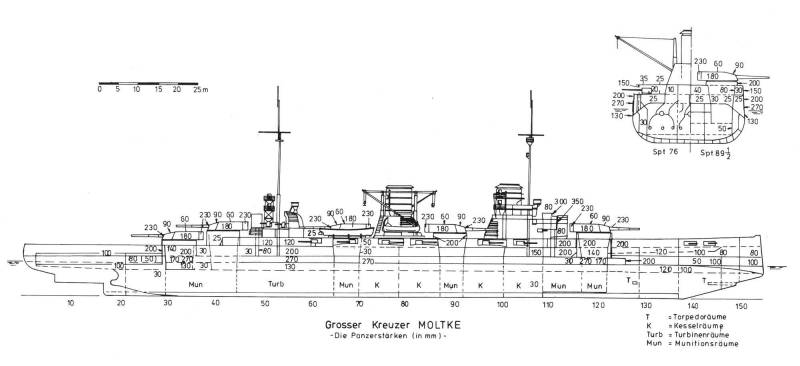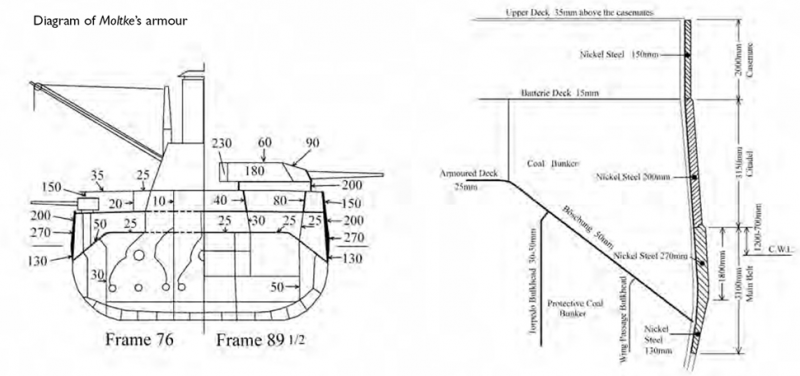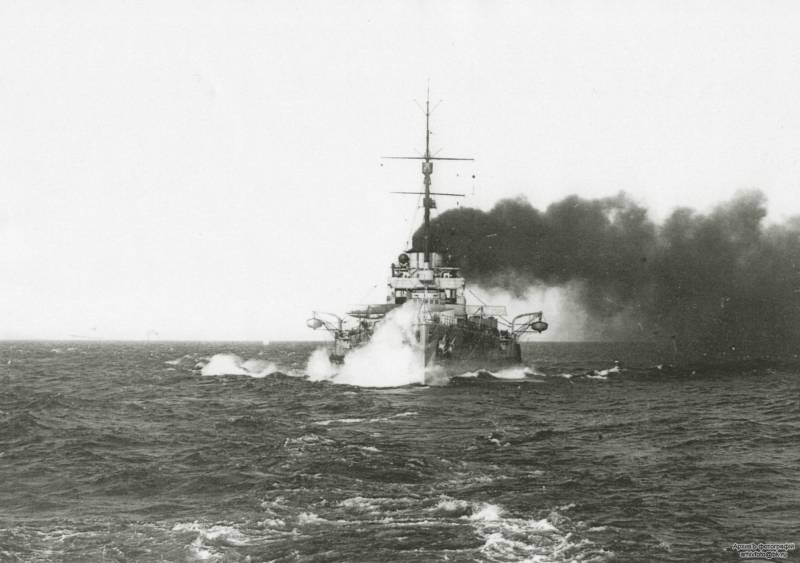Line Cruiser Rivalry: Moltke vs. Lion
So, 23 on April 1907 Mr. von Tirpitz stated (verbally) that the new cruiser should become an increased Von der Tann. In response to this, the design office submitted an entire memorandum to 2 in May of 1907, which substantiated a slightly different vision of the new battlecruiser. It must be said that G. Staff does not assert anywhere that Tirpitz proposed building a new cruiser with eight 305-mm cannons, but judging by the arguments of his opponents, he meant exactly that.
The design bureau recognized that it was possible to create a battle cruiser with eight newest 305-mm guns within the allocated budget, but suggested not to do so. It was motivated as follows - although, without any doubt, the newest battleships require twelve-inch guns, but the cruiser will have enough 280-mm, perhaps not quite optimal, but still quite suitable for battle with battleships. Instead of increasing the caliber, you should increase the number of guns - this will allow the "big" cruiser to fire several targets at the same time, which is extremely important in a naval battle against the superior British forces. Therefore, it was proposed to leave the 280-mm caliber gun on the new cruiser, but increase their number to twelve. The reservation had to correspond to the “Fon der Tannu”, the speed - not lower than 24,5 nodes.
In response, the Imperial Maritime Ministry responded that the argument of the Design Bureau about the need to increase the number of main-caliber barrels is flawless (!), But still there are no twelve guns needed for the stated goals, ten is enough. At the same time, Admiral von Heeringen pointed out that 305-mm guns on battleships appeared not because of someone else's whim, but because they best meet the tasks of a squadron battle, and if so, then “big” cruisers should be armed with 305-mm guns . The admiral also pointed out that the recent calculations for one of the projects of the high-speed battleship armed with 10 280-mm guns showed that such a ship is possible in a displacement of 20 300-20 700. Now you can build a larger cruiser, so the additional displacement is quite can be spent on 305-mm guns.
In general, the Imperial Maritime Ministry proposed to build a battle cruiser with 10 305-mm guns, arranged according to the “Dreadnought” scheme, while the protection had to correspond to “Fon-der-Tann”, the speed - not lower than 24,5 knots.
As a result, 17 May 1907 g final decisions were made on the future cruiser. We stopped at 10 280-mm guns, the same that were installed on the “Fon der Tann”, the speed should be from 24 to 24,5 knots, the displacement should be no larger than the modern battleship, that is, of the order of 22 000 t (this is how the newest dreadnoughts like "Helgoland" were seen then). At the meeting, in the presence of all interested persons, they also sketched out a map of the location of the artillery of the future "big" cruiser.
Interestingly, even then there was a concern about the linearly elevated placement of the feeding towers - it was rightly noted that since they are located very close to each other, they can be put out of action with a single successful hit.
The design of the cruiser showed that these innovations would require an increase in the Fon der Tanna displacement on the 3 600 t, including the 1 000 t - to increase the side height, 900 t - on the additional tower of the 280-mm guns and the corresponding extension of the citadel, 450 t - additional weight of machines and mechanisms; 230; t - other needs; and 1 000; t - an increase in the geometric dimensions of the body so that all of the above can fit in it. However, this seemed excessive von Tirpitz, because it went beyond the previously indicated 22 000 t displacement. In response to this, a small “revolt of designers” took place, offering to completely abandon all kinds of innovations, and build a “big” cruiser in the image and likeness of “Von der Tanna”. It was stated that it was impossible to “shove” the required innovations in 22 000 t, that the design offices were overloaded with work, that in England they built three Invincibles and did not lay down new ones, apparently waiting for the test results of the first series of battle cruisers and only Germany builds every year off-series large cruiser, each time a new project.
Nevertheless, of course, the admirals insisted, and the ship was built according to a new project. The normal (full) displacement of the battle cruiser Moltke was 22 979 (25 400) t.
Artillery.
As we said earlier, eight 280-mm / 45 guns were installed in four two-gun towers on Fon der Tann. The project was supposed to install ten such guns on the Moltka, but in fact the ship received more powerful 280-mm / 50 artillery systems. The Von der Tanna guns sent projectiles with an initial speed of 302 m / s in the 850 kg flight, while the Moltke guns were 895 m / s. Without a doubt, the armor penetration of the main caliber "Moltke" has grown, and in the same way could have increased the firing range. But alas - if the maximum angle of elevation of the guns of the “Von der Tanna” was 20 degrees, then “Moltke” - 13 degrees. As a result, the firing range decreased from 18 900 m to 18 100 m and only in 1916 g, after increasing the elevation angle to 16 hail. reached 19 100 m. Ammunition remained at the same level: “Moltke” had a 81 projectile for each weapon against 82-83 on “Fon der Tanne”, but the total ammunition, due to the addition of a two-gun turret, increased, of course, from 660 to 810 shells. Of course, all 10 guns of the main caliber "Moltke" could fire on one side.
The medium caliber was represented by the same 150-mm / 45 guns that were installed on the “Fon-der-Tanne”. Their ammunition consisted of 50 armor-piercing and 100 high-explosive 45,3 kg shells, which these guns were able to send in flight with an initial speed of 835 m / s at a distance of 13 500 (73 cab.), And after upgrading the range of fire increased to 16 800 m (XNUM) cab.). The only difference was in the number of these guns: “Von der Tann” carried 91 10-mm / 150 guns, and “Moltke” - two more.
The anti-mine caliber was introduced by a dozen 88-mm / 45 guns firing 10,5 kg shells with an initial speed of 750 m / s on the 10 700 m. (58 cab.). Von der Tann was equipped with the same weapons, but there were sixteen of them on the first German battle cruiser.
As for the torpedo armament, there were four 500-mm torpedo tubes on the Moltka (450-mm on the Fon der Tann), two of them were placed in the bow and stern stems, two more - in front of the bow 280-mm turret towers. Total ammunition was 11 torpedoes.
Reservations.
The booking of the Moltke battle cruiser was very similar to that of Fon der Tanna, although there were some differences. In addition, the sources, alas, do not contain some data on the “Von der Tann”, while on the “Moltke” they are.
The basis of Moltke’s armor protection was two armored belts. The bottom one had a height of 3 100 mm. From the top edge and over the 1 800 mm, the belt had a 270 mm thickness, and on the remaining 1 300 mm, it gradually became thinner to 130 mm. At the same time, the 270 mm section went under the waterline at 40 (according to other data, at 60 cm) and, accordingly, rose above the water only at 1,2 - 1,4 m. The difference from Fon der Tanna was that, judging by In all, Moltke’s “thick” section of the armor belt was higher (1,8 m versus 1,22 or 1,57 m) while its thickness exceeded that of Fon der Tanna by 20 mm (270 mm against 250 mm), but on the bottom the edge of the Moltke belt has “lost” the same 20 mm (130 mm against 150 mm).
On top of the lower armored belt was the top - this one had a height of 3 150 mm and the same thickness 200 mm throughout its length. The difference from the “Fon der Tanna” here is that, opposite the “traversing” towers of the main caliber of the Moltke armor belt, the Moltke had no increase in thickness to 225 mm.
Accordingly, the Moltke side protected the entire length of the citadel on 6 250 mm, with the first 3 150 mm having a thickness of 200 mm, then 1 800 mm - 270 mm and lower 1,3 m smoothly thinned from 270 mm to 130 mm. The citadel covered not only the engine and boiler rooms, but also the feeding tubes and cellars of the towers of the main caliber, including the bow and aft towers, but still the stern tower was not completely covered up. Outside the citadel, the board was booked the same way, but had a lightweight protection - 120 mm (closer to the stem - 100 mm) in the bow and 100 mm in the stern, while the thickness of the 100-120 mm armor plate was reduced to 80 mm to the upper edge. At the same time, the last 3 meters of the stern remained unarmoured, but there was a 100 mm traverse that closed the 100 mm of the armored belt. Above the citadel (but not all along its length), casemates of 150-mm guns were located, which, like Fon der Tanna, were armored with 150 mm armor plates. Accurate data on the traverse is not, judging by the descriptions of G. Staffa, they had a variable thickness from 140 to 200 mm.
The Moltke armored formwork had the same thickness of armor (25 mm in the horizontal part and 50 mm bevels), but its shape was slightly different from Fon der Tanna: the horizontal part occupied a large area, and the bevels were located at a large angle (not 30 , and 37 hail). As a result, the barbettes of all the Moltke towers “got up” on the horizontal portion of the armored decks, but a greater angle of inclination relative to the deck and a smaller angle relative to vertical protection resulted in less armor from the effects of projectiles during flat shooting. However, the changes here were minor, if not to say - negligible. We also note that the horizontal part of the armor deck was at a height of 1,6 m above the waterline.
This armored form protected Moltke within the citadel, but, as follows from the description of G. Staff, it ended without reaching 12 m before the end of 270 mm of armor in the stern. From here to the stern, at the height of 45, see below the waterline, there was a horizontal armored deck without bevels. It had a thickness of 40 mm in the 270 mm area of the armored belt and 80 mm - further. In the nose of the citadel, the armor deck was at the level of the waterline at a height of 50 mm, curving downwards closer to the stem.
Above the armor deck at the “Fon der Tanna” only decks were armored in the area of the casemates (or simply had an increased thickness - 25 mm each). As far as can be understood, the same thing was on Moltke, except that the casemate’s “ceiling” was still 35 mm.
The conning tower’s armor thickness reached 350 mm, but was not uniform, the side walls had 300 mm, the rear wall had 250 mm, the roof was 80 mm. The protection of the towers corresponded exactly to Fon der Tannu, front sheets and rear wall 230 mm, side walls 180 mm, inclined sheet in front of the roof 90 mm, horizontal part of the roof 60 mm, flooring in the rear part of the tower 50 mm. But the barbets booking had some differences. In the extreme towers of both battlecruisers, half of the barbet, facing the bow and stern respectively, had 230 mm of armor, the rest of the barbet - 170 mm. The traverse towers of Fon der Tanna had 200 mm barbety to 25 mm deck, and below it only 30 mm. Moltke towers up to 35 mm decks had the same 200 mm, but lower - up to the “floor” of the casemate, i.e. where the board was protected by 150 mm armor, the thickness of the barbet was 80 mm from the nearest side and 40 mm from the opposite side.
An anti-torpedo armored bulkhead with a thickness of 30 mm was installed on the “Fon der Tanne”. "Moltke" received the same, but in the area of artillery cellars, its thickness increased to 50 mm.
In general, Moltke’s booking was somewhat more rational and powerful than that of Fon der Tanna.
Power plant.
Machines and boilers capable of developing the rated power of the 52 000 hp were installed at Moltke, and it was assumed that the speed of the 25,5 nodes would be reached. On tests, the power was significantly exceeded and reached 85 782 hp, while the speed reached 28,074 knots. The maximum recorded speed was 28,4 kn (at what power - alas, not reported). During the six-hour run, the average cruiser speed was 27.25 knots.
The coal reserve was 1 000 t in normal and 2 848 t at full displacement. Unfortunately, Moltke's tests for the economic course (12 nodes) were not carried out, but it can be assumed that they were quite equivalent to the same type of “Goeben”, whose stroke range was determined from test results both by calculation and at speed:
27,2 knots - 1 570 miles;
20 knots - 3 200 miles;
17 knots - 4 230 miles;
12 knots - 5 460 miles.
An interesting point - the author of this article for a long time did not understand why the German battleships had a bottom in the vicinity of the stem, as it were, “cut off”, forming something more similar to an icebreaking bow. As it turned out, this sharp “rise” to the stem served the one and only goal - to ensure the best agility of the ships during the shifting of the rudders.
Moltke was built on the 1908 g program and was laid out in April 1909 g, 7 was launched on April 1910 g and 30 September 1911 g was put into operation - a very outstanding result, even if you do not take into account the 2,5 month shipyard strike (4 August - October 20 1910 d), during which the construction of the battlecruiser was not conducted. The next battlecruiser of Germany, the Goben, was built under the 1909 program, and was a ship of the same type as the Moltke. “Goeben” was laid on 28 August 1909 g, lowered 28 February 1911 g and commissioned 2 July 1912 g.
What can be said about the second and third battlecruisers in Germany? Without a doubt, the Germans turned out powerful and well-protected ships. But, oddly enough, it is much more difficult to evaluate the Moltke project than the previous Von der Tannu. On the one hand, everything seems to be simple. In previous articles, we compared the Von der Tann and the British Indefatigeble, and came to the unambiguous, indisputable advantage of the Von der Tanna over the English battle cruiser. But it should be understood that such a comparison, in general, is not entirely correct. The fact is that “Fon der Tann” was laid 21 March 1908 g, almost a year before “Indefatigebla”, whose bookmark took place 23 February 1909 g. And, if we compare the ships in accordance with the timing of their laying, the British battlecruiser second the series should not be compared with Fon der Tann, but with Moltke, laid down some 2 months after Indefatigeble.
Of course, it is even indecent to even compare Indefatigeble and Moltke, as if you rate the chances of a twelve-year-old fighter against an Olympic boxing champion. It can only be stated that the German naval and design ideas were colossally ahead of the English in the creation of battlecruisers. And how can you not remember the boastful words of D. Fisher expressed in a letter to Lord Asher, dated September 1908 g:
Considering the fact that the Germans immediately after the “Indefatigebla” and long before the “New Zealand” with “Australia” laid the battle cruisers, which were almost 4 400 tons heavier than the English, had ten very powerful 280-mm guns, exceeding the English 305 in armor penetration -mm / 45 guns and, with equal speed, had armor in 200-270 mm where the English had only 102-152 mm, German sailors could gnash their teeth only in order not to burst out laughing out loud.
Of course, England almost never attempted to build ships that did not have peace in the world, preferring the relative cheapness and massiveness of construction to high individual TTX, but, oddly enough, at the time of laying the Moltke and Geben, and with the English, things were not so hot. By the time the Gebena was laid, the British had XVUMX-type Invincible battlecruisers in the ranks and one (Indefatigeble) in construction, the Germans in three battlecruisers in construction.
But on the other hand, shortly after the laying of the Goeben, in England they began to build a second generation of battle cruisers - in November, the Lion was laid out with the 1909-mm guns and 343-mm armor belts. And this was a completely different opponent.
Продолжение следует ...





Information